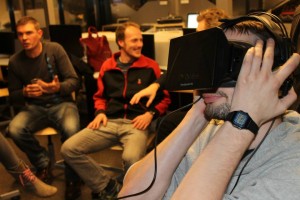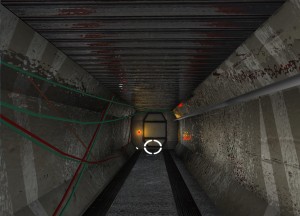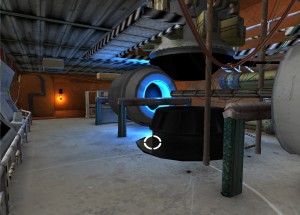How students at SAE Amsterdam are using the Oculus Rift to make state of the art games.
The head of department, Dennis Boersma was one of the early developers of the Oculus Rift and he sees the opportunity of incorporating it into everyday gaming as a great thing. “I think the future of gaming is very exciting and games will become much more immersive, so that they are not just something to play, but something to experience.”
text: Gordon Todd
As you might expect, Interactive Animation students at SAE Amsterdam are driven to create games they would like to play themselves, guided by their own experiences of what works and what doesn’t in a game. Many students, like Thijs Willemsen (currently studying for his BA at SAE Amsterdam) see their studies as an ideal opportunity to take their hobby to the next level. They are guided towards their dreams by the staff, each with different specialties, but all working together to produce work which everyone can be proud of.
Becoming firmly established in the current games that students make is the Oculus Rift headset. Looking like something out of a science fiction movie, it contains 2 screens which the viewer sees simultaneously, one for each eye at a slightly different angle. These screens mimic real-world perception and give the player the feeling of total immersion in the game they are playing.
What sets the Oculus apart from attempts at 3D viewing which have come before is that the headset is also fitted with motion tracking sensors which react very quickly to the player’s movements. When you turn your head in any direction, your character will do the same in the virtual world, creating a feeling of immersion so realistic, that first time users are surprised when they look down and can’t see their own bodies.
BA and BSc students have the opportunity to work on Rollercoaster projects which can be viewed through the Oculus Rift. The illusion is so real for some that they experience motion sickness and make the same noises they do on a real roller coaster!
First introduced two years ago, the Oculus Rift has still not been released to the public, but the developer kit is generating a lot of interest and enthusiasm. Most recently, Mark Zuckerberg, founder of Face Book bought the company, perhaps indicating the importance and potential of this new technology.
The race to win over gamers is well and truly underway with Sony also releasing their 3D Virtual Reality Headset to developers, and Google Glass continuing to cause controversy, even if it is not yet clear just where it will fit into the scheme of things.
With the potential of the Oculus at the forefront, Dennis Boersma and his game development team have incorporated it into their latest game, “Float”, which is playable on a normal pc, and also with the Oculus Rift.
As the game begins, you awake on a spacecraft, which is adrift. Players have to familiarize themselves with the ship and the controls in their new Virtual environment before they are thrown into the action. A combination of different skills is required in order to beat the clock and survive this potentially disastrous situation.
All the 3D models and environments were created by students and they were then assisted in the programming by Dennis. The latest versions of Unity, 3DS Max, Maya, Photoshop and Crazy Bump were used, giving students great experience in a variety of different working methods and skills to complete the different features of the game.
The IA course at SAE Amsterdam gradually builds up students’ experience in many different aspects of character modeling and game design within only one year of study. “Float” is the end result of an intensive three months work by the students of IADF 1012 who created it as their end project.
You might think that the course was already quite intense in terms of workload, but it is a testament to the dedication of students and staff alike that they also participated in Development Nights.
Development Nights, affectionately known as “Dev nights” take place sporadically at SAE, usually from a Saturday afternoon to a Sunday morning, although some have gone on longer with students and staff working around the clock on a game. Interactive Animation students join forces with Audio students to create a new game level, or perhaps to improve an existing level. The catering of choice is Pizza, what else, and the students who work together tend to form closer bonds in their future careers.
During Dev nights, students really get to understand some of the real-life pressures which can be brought to bear when trying to meet deadlines. It is on these occasions that students get a taste of working in a real, competitive gaming environment and learn new vocabulary, such as “Crunch Time”, “Optimization” and, if they still haven’t learned it “Naming conventions”!
Watch the video presentation of the game below (Vimeo)




